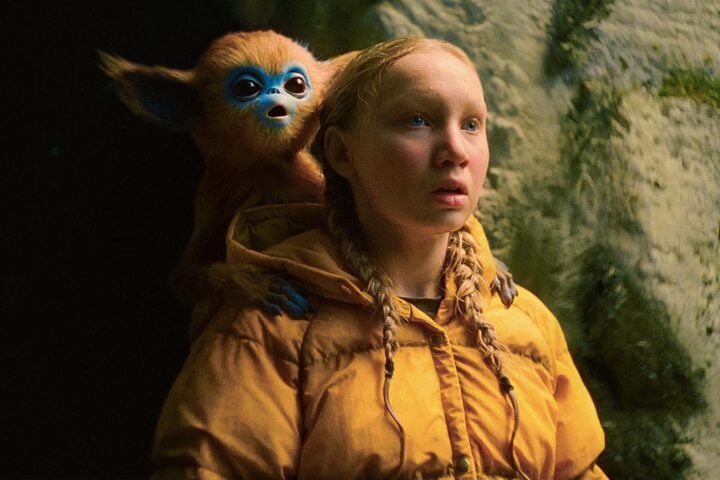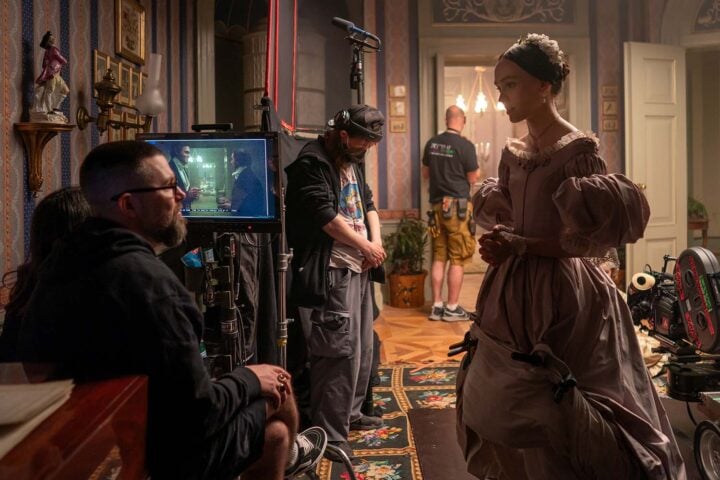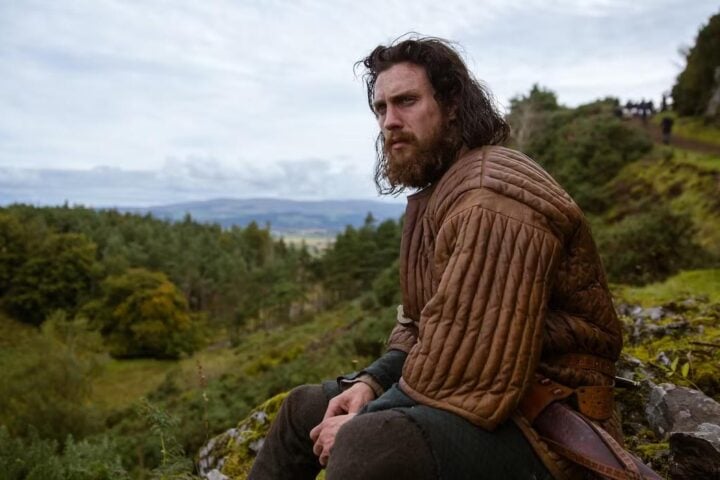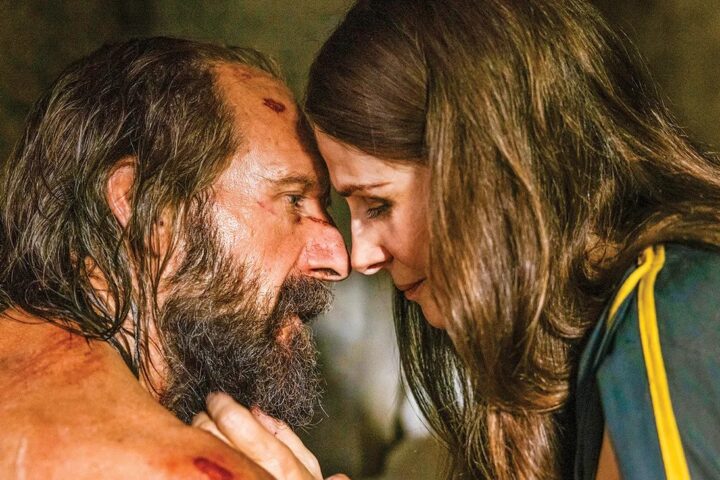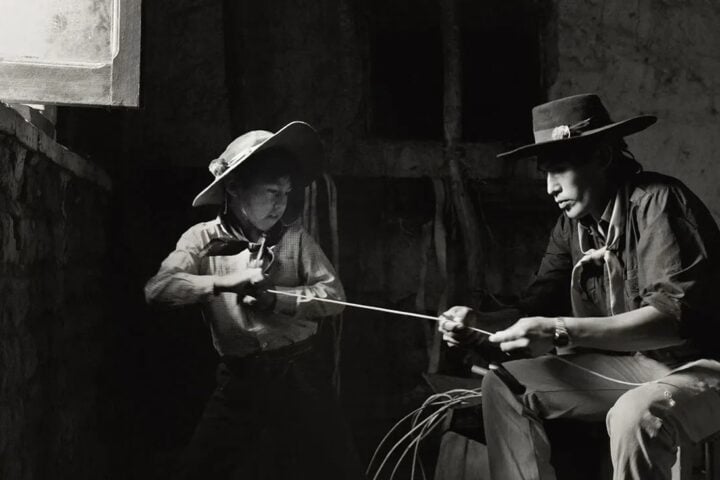The subtitle of F.W. Murnau’s 1922 silent feature Nosferatu—an unauthorized adaptation of Bram Stoker’s 1897 novel Dracula that became a touchstone for both cinema scholars and fright-movie buffs—was true to its grandly German Expressionist vision: “A Symphony of Horror.” Robert Eggers’s sublimely severe remake of the oft-told tale of a bloodsucker wreaking unholy havoc is less a composition for full ensemble and more a moody piece of chamber music, equally as orchestrated as the Murnau, but uncomfortably intimate in its effects.
From the first single-take sequence in which Ellen Hutter (Lily-Rose Depp) weepily materializes from pitch-blackness, the palpable auras of dread and devilry feel like they’re emerging from a collectively damaged psyche. Every character is bonded by the pervasive doom and gloom, which Eggers and cinematographer Jarin Blaschke emphasize in that same opening shot when they follow Ellen out of the darkness until she faces her monstrous seducer, Count Orlok (Bill Skarsgård), his hulking silhouette cast against curtains billowing in the night breeze.
The elegance of this fluid composition, the way it moves from a chiaroscuro close-up to a tenebrous two-shot, shouldn’t be surprising to anyone familiar with Eggers’s prior efforts. He makes movies about the past that strangely eschew nostalgia, inhabiting an alien—and, to some, alienating—world that speaks to no moment outside his own eerie and eccentric purview. “I am an appetite!” seethes Orlok in a telling exchange, one that hints at the degree to which Eggers’s cinema has an aesthetic ravenousness about it that’s both stylish and sequestered.
That cloistered quality has pretty much always worked to his previous films’ advantage, and so it does again in Nosferatu. The majority of the movie is composed of two-to-four-character interactions. What few crowd scenes there are act like tonal punctuation, conveying the grimy 19th-century settings—primarily the fictional German shipping town of Wisborg and Orlok’s hazy Carpathian environs—with a penumbral, broad-brushstroke evocativeness.
Mostly, the plot circles around Orlok and Ellen; the latter’s real-estate agent husband, Thomas (Nicholas Hoult); the Hutters’ relatives Friedrich and Anna Harding (Aaron Taylor-Johnson and Emma Corrin); Thomas’s deranged boss, Knock (Simon McBurney); gruffly pragmatic physician Dr. Wilhelm Sievers (Ralph Ineson); and slightly certifiable alchemist Professor Albert Eberhart von Franz (Willem Dafoe). Throughout Nosferatu, the characters orbit each other with a mesmeric languor, as if they were unconsciously performing a slow dance to the death. Horrible outcomes feel inevitable and many of the people on screen do indeed come to as bad ends as the pigeon that Knock beheads with a gluttonous bite.
If there’s any romance here, it’s less in the interactions between Ellen and her undead courter than in the way Eggers himself interacts with this orgy of destruction, like a modish man of science blissfully observing two or more predatory organisms under a microscope. This is poetry at the level of empiricism, and an acquired taste for sure. Yet the beauties are nonetheless abundant, from the disquieting blue and gray tints over several scenes (an homage to the 1922 feature that nonetheless feels distinctly Eggers’s own) to the conception of Count Orlok as a mustachioed, flesh-decayed ogre with a hellishly thundering voice.
Both Max Schreck in the Murnau and Klaus Kinski in Werner Herzog’s superb 1979 remake emphasized Orlok’s rat-like regality, each of them toothily insatiable wraiths from beyond. Skarsgård, unrecognizably encased in pancake and prosthetics, goes more in the direction of ape-like entitlement, dragging his diseased bulk around as if none can, or will, deny it. He’s a king weighed down by the remnants of human life, a shadow of a man who still has the power to bring about apocalypse. It’s an inspired take on a role that usually tends toward the resplendent.
The rest of the cast holds their own, though it’s the stalwarts like McBurney, Ineson, and Dafoe who are most attuned to Eggers’s wavelength. No surprise that Dafoe can take a purple-prosy line like “I have seen things that would make Isaac Newton crawl back into his mother’s womb!” and infuse it with both mirth and pathos. Of the younger cast, Hoult proves strongest, particularly in his initial scenes with Skarsgård, wherein Thomas’s transfixed terror is agonizingly tangible, while Taylor-Johnson and Corrin ably portray characters whose constant denials of dark and demonic forces ultimately lead them astray.
Depp, meanwhile, isn’t a weak link so much as an endearing try-hard, contorting her possessed body into impossible positions, running the gamut of emotions from the hornily rageful to the tearily apologetic. Ellen was originally supposed to be played by Eggers’s frequent collaborator Anya Taylor-Joy, and it’s easy to imagine that performance being more consistent and confident. Yet there are still plenty of moments in which Depp brings herself to the perfect peaks of passion, particularly during the climax as she tempts Orlok to his sun-dappled comeuppance. And even when the players are in a valley, Eggers helps them along with stylistic pirouettes and cinematic shadowplay as beguiling as any Transylvanian vamp in heat.
Since 2001, we've brought you uncompromising, candid takes on the world of film, music, television, video games, theater, and more. Independently owned and operated publications like Slant have been hit hard in recent years, but we’re committed to keeping our content free and accessible—meaning no paywalls or fees.
If you like what we do, please consider subscribing to our Patreon or making a donation.


